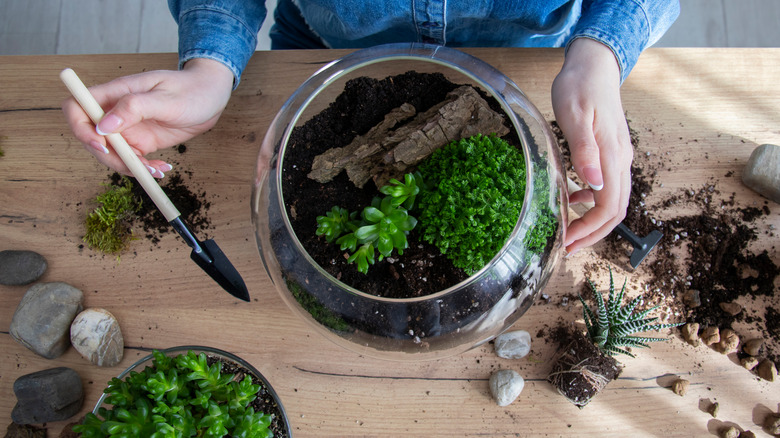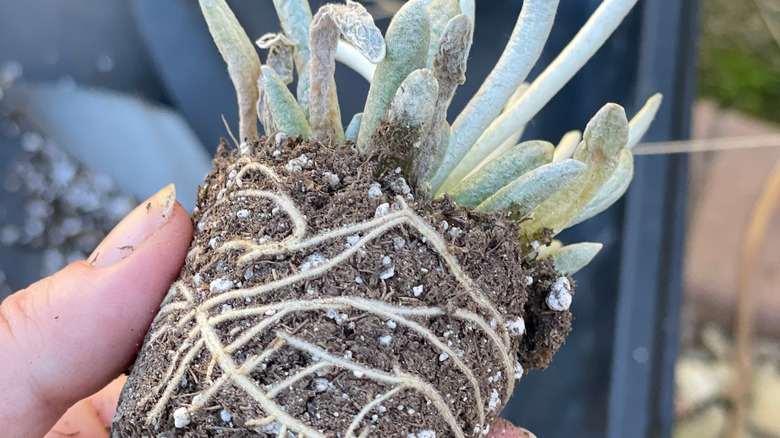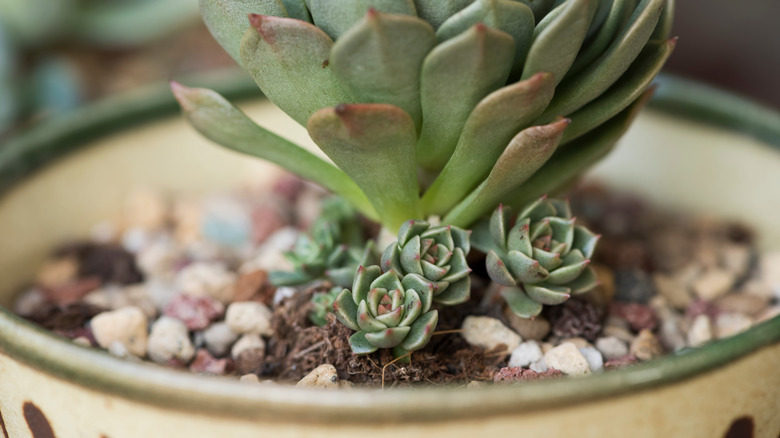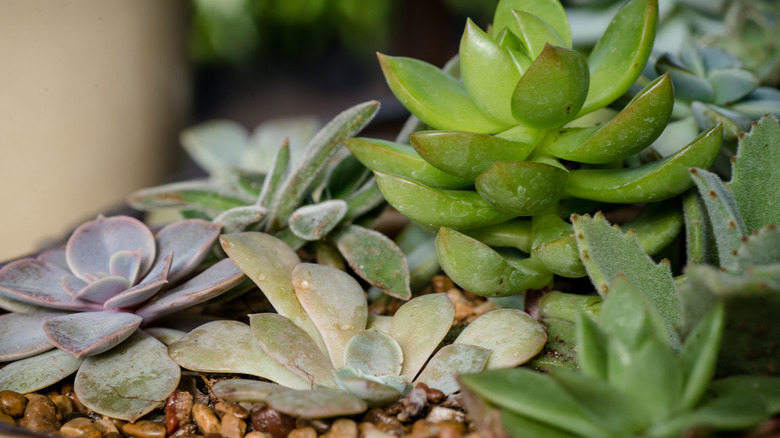How To Propagate Succulents
We may receive a commission on purchases made from links.
You can call them plantlets, chicks, pups, or offshoots, but most gardeners know them as fleshy, low-maintenance plants that retain water in arid climates and soil conditions. Succulents are one of the easiest plants to propagate, typically from a little snip of leaf or stem called cuttings, which produce fast roots and new plants, according to the Gardener's Path. Even for the most novice gardener, these plants have made multiplying the beauty and variety of their water-storing leaves and stems as simple as possible.
Succulents can grow as tall as 20 feet or stay as tiny as 8 centimeters, via the World of Succulents. They primarily hail from parts of Africa, says Succulent Alley, but some originate from parts of the West Indies to southern Canada. These plants have shallow roots, which means even the groundcover varieties are noninvasive and can easily be replanted in different parts of your garden, per Succulents Addiction. They are nature's cool, calm, and collected plants that require little attention. However, the right sunlight, season, soil, and watering plan will make all the difference when propagating your succulents. Keep reading for a guide on propagating your own indoor or outdoor succulent treasures.
Signs your succulent needs propagating
According to Needles + Leaves, it is time to consider propagating your succulents when they look "leggy" or stretched out with a stem that is getting barer by the minute, thanks to wilting leaves. Another sign that it's time to start clipping and replanting is when the rosettes loosen their compact shape, a process called etiolation, per Succulents and Sunshine. Also, watch for succulent roots that begin to show up on the soil or check for roots poking through the holes under your drainage pot. This is a signal that your succulent is outgrowing its current space and requires a new home, via MasterClass. Additionally, keep an eye out for soggy soil or mold on the surface of your succulent soil. These are all tip-offs from your succulent, alerting you to propagate to a bigger pot and add fresh soil.
Outside succulents might initially thrive as a cluster when first planted, but they can grow so densely together that it causes problems — like water not reaching their roots, says Succulents and Sunshine. This situation might signify a much-needed pull-up, untangling of roots, and propagating into other spaces in your garden. You can also start thinking about propagating when your succulent sprouts its first "pups," says Gardening Know How. They suggest that a good rule of thumb is to let your succulent offshoots grow to the size of a quarter before harvesting.
Handing succulent pups or cuttings
Using pups, leaves, or stems to propagate your succulents, callusing your cut before replanting, and keeping your baby succulent temporarily out of direct sunlight will improve your chances of success, per Succulent Plant Care. To begin propagating, start by using any sharp garden tool or cutter and snip the pup from the mother plant. Attempt to keep any affixed roots as intact as possible by shimmying a sharp tool down into the soil between the mother plant and pup. Set aside the pup or leaf cuttings to dry for a few days, says Needles + Leaves.
The pup or leaf will callus at the end, keeping it from soaking up too much water when it is first planted in its new soil, which should be a mix that gives the succulent's roots room to develop and drain effortlessly. Succulents grow best in a cactus mix, or some gardeners, like the Instagram plant guru, @highway92succulents, prefers to make her own by combining 2⁄3 potting soil with ⅓ perlite or volcanic pumice.
To plant your pup or leaf cutting, use any gardening tool or finger to poke holes into the soil, and tuck your new pup or leaf in firmly, patting the soil in place until it can stand upright, says Ohio Tropics. After an initial soaking, resist watering again until the soil is dry. Place your burgeoning succulents out of the direct sun but still in a bright space.
What to avoid when propagating
According to Succulent Plant Care, overwatering and choosing poor-quality cuttings are some of the top reasons propagating succulents can fail. Gardeners should resist watering new succulents until their soils have completely gone dry. As for cuttings quality, you can learn over time which cuttings look thick enough and therefore viable for propagating. You can also simply hedge your bets by propagating more than just one or two leaves and offshoots at a time. But one mistake some gardeners make is failing to consider the varied dormancy seasons of succulents.
The best time to propagate succulents is just before their growth season, says the Succulents Box. However, this is easier said than done since succulent dormancy seasons vary. For instance, according to Harddy, a few popular succulent varieties that produce offshoots for propagating are Echeveria, Haworthia, Sempervivum, and Graptoveria. These varieties are winter dormant, so their pups should be snipped and propagated in the spring and summer. However, Aeoniums also reproduce from pups, says Aeonium Australia, but they are summer dormant. Gardeners will want to propagate these pups in the fall.
It is true that you can propagate year round, assures Martha Stewart. However, according to The Spruce, plants have built up their best energy storages after their dormancy seasons and can heal from the trauma of shears and replant quicker in their growth season.



